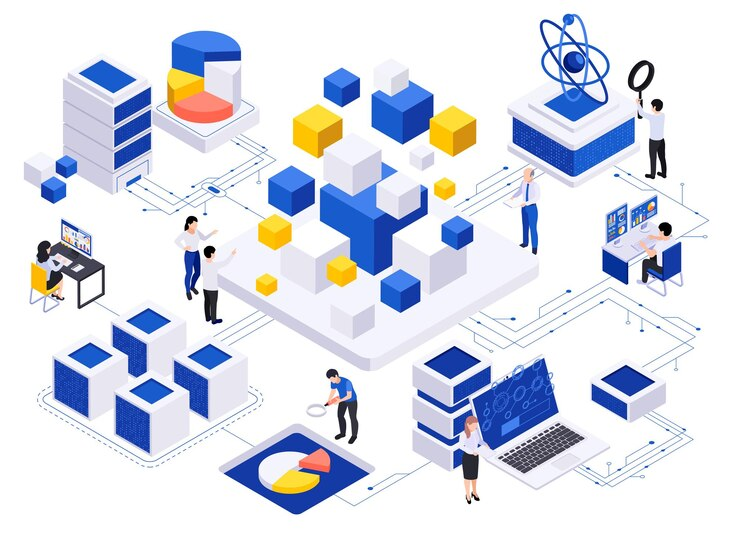The Future of Microservices: Software Trends in 2024
ByJulian Gette
Workast publisher

Workast publisher
It is now 2024, and microservices are still considered transformations within software development. Microservices, an architectural approach to developing an application as a set of discrete and deployable services, have changed the paradigm of developing and maintaining software in enterprises. Compared to the monolithic architectures that dictate all components of an application to work in unison, microservices offer a multipart system that can be developed, deployed, and scaled differently by teams. In 2024, microservices architecture will be even more significant as it will enable teams to work on various aspects of an application at once, making the process faster and encouraging innovation.
The concept of microservices has gained popularity due to a variety of benefits it has over the monolithic architecture approach. In a monolithic structure, all modules share much in common and are interdependent; hence, the entire application environment is affected when developing new functionalities or optimizing an application. On the other hand, microservices architecture development services are supposed to be loosely coupled and self-contained. While this compels originality, dynamism, and high availability, it also entails a complete conniving of concerns that accelerate businesses’ resurgence. Thus, it is possible for companies to align the technology stack with the characteristics of each service, thereby achieving efficiency and economical results. Microservices development services such as https://expert-soft.com/solutions/microservices-architecture/ offer businesses the ability to create tailored solutions that meet specific needs, enhancing overall productivity and scalability.
Now, let’s discuss some of the basic benefits that embrace the decision to implement microservices for modern software developments.
1. Scalability
This means that it is possible to scale every microservice according to the required load, which in turn makes the best use of available resources and easily achieves performance control. This is especially useful for applications with random workloads, where some services require more loads than others.
2. Flexibility
Microservices can be developed, deployed, and operated autonomously, which means that a particular team is free to use the most appropriate technology stack for the particular service. This allows organizations to use their technological resources more flexibly, free themselves from vendor lock-in, and use the most modern technology in software development.
3. Resilience
One microservice does not affect the other microservices in the entire system, so there is no single point of failure. Indeed, this isolation enhances the functionality of the overall system and makes it less prone to specific faults. In this way, microservices correct for numerous failures as they isolate the problem at the service level, hence improving the stability and reliability of applications.
4. Faster Development and Deployment
Due to parallel work on different services, more services can be developed in a shorter period of time, and thus, the products can be brought to the market faster. Microservices make Automated Integration and Deployment more achievable, making it easier to bring in updates more often and more securely.
5. Better Resource Management
Microservices architecture helps in effective resource utilization, reducing costs, and improving system efficiency. Different services can require different amounts of computational processing and storage facilities; therefore, different services can be provided with different amounts of computational power and storage.
6. Improved Collaboration and Productivity
The idea decomposition enables teams to target and complete smaller portions of applications at once, improving efficiency. It also makes the approach modular and, therefore, well suited to the principles of agile methodologies where the development is performed iteratively.
The use of microservices is increasingly becoming popular. As per the Gartner report, around 85% of new applications will adhere to a cloud-first principle by 2025, which will further increase the usage of microservices architectures. Similarly, Industry Research indicates that the global microservices architecture market is expected to grow at a compound annual growth rate (CAGR) of 18.6% from 2020 to 2026, highlighting its increasing significance in the software development landscape.
When speaking of microservices, here are several trends microservices in 2024 that take place and which can be considered as future directions in the development of microservices. These microservices trends follow the dynamics of the software market and the need for further development of new architectures, presence, and new ranges of efficiency, scalability, and resistance to external impacts. Ranging from the utilization of serverless computing to the adoption of artificial intelligence and other advanced technologies, these trends are what redefines the potential of microservices. Below is a brief discussion of some of the most popular trends Microservices:
Microservices architecture is getting adopted more and more as a way to deploy an application based on serverless computing. It hides the underlying system and gives developers the best environment to develop their codes. This trend enhances operation simplicity and cuts operating expenses since such models are granted resources on demand without owning the infrastructure. For a developer, both serverless and microservices are perfect, they provide unparalleled freedom and efficiency. When it comes to serverless microservices, applications can be launched faster, they are easy to scale, and consumption-based, which, therefore, makes it a very cheap solution.
Containerization using tools like docker bundles microservices and its dependencies in a particular stack and helps achieve stack consistency in different environments. Operating in containers offers several advantages, such as low resource utilization, portability, and the ability to achieve a uniform environment when developing and deploying software applications. Kubernetes, is a container orchestration system that is open source and has gained general acceptance for managing containerized workloads. Kubernetes enables application containers to be deployed, scaled, and managed automatically, thus facilitating the management of a large number of microservices. In this way, using Kubernetes, it is possible to make an application available, fault-tolerant and capable of expanding to match the demand.
A service mesh, therefore, is a special layer in the system designed to manage how services interact with each other to support safe, fast, and reliable interactions. Some of the examples of those are Istio and Linkerd, which already bundle features such as load balancing, encryption, or monitoring by default. Service meshes further improve the visibility and protection of microservices, which is particularly valuable for complicated environments. Since they separate the communication logic from the application code, service meshes help simplify the management and building of microservices since development teams are not troubled by issues related to the infrastructure.
One of the most discussed microservices trends in 2024 is MACH (Microservices, API-first, Cloud-native, and Headless) due to its modularity. Using this architecture, organizations can develop applications that are agile, adaptable, and responsive to the ever-evolving requirements of the business. MACH also has a flexible approach where each framework can be built, run, and updated without affecting the other parts, making it easier for businesses to meet emerging market needs. MACH architecture’s philosophy is aimed at the usage of best-in-class technologies that allow the building of highly customized solutions. Due to design and modular flexibility, MACH architecture supports the integration and reuse of applications and services as needed.
IT Operations are therefore amplified through the use of AI and machine learning, commonly referred to as AIOps, for microservice management. AIOps platforms enable quick data analysis by implementing machine learning that analyzes the volume data provided by microservices to identify issues, and pre-existing symptoms and then respond automatically. This integration enhances the stability and quality of microservices and therefore enhances their functioning. The use of AI and necessary analytic tools in the operation and management of microservices provide organizations with solutions that are both time-saving and efficient in eliminating larger proportions of the problems associated with these services.
Microservices cannot be implemented without adopting DevOps practices of working. Continuous integration and continuous delivery of workflow systems guarantee effective and constant releases. DevOps culture enables cross-functional relationships between the development teams and operation teams hence means that microservices are produced, tested, and released in the market in the right manner. It is evident that DevOps and microservices are complementary as they foster fast-paced innovation. DevOps practices aim to integrate, automate, and improve the efficiency of the delivery of an organization’s software applications.
AWS, Azure, and Google Cloud are some of the cloud vendors that indubitably give incredible support to microservices. Software services that are built around cloud operating models, like managed databases, messaging queues, and serverless, run well with microservices architecture. That is why cloud platforms are scalable, flexible, and reliable, and they have become the best platforms to host microservices-based applications. If organizations deploy and make use of cloud services, they are capable of managing their applications in a more efficient way to maintain their agility and, at the same time, release some of the technical burdens that render an organization’s operation overhead. Global access is made easy through cloud implementation so that organizations can serve customers in the worldwide market with low latency and high availability.
Sustainable application development aims to promote energy conservation and enhance the environmental standards of computer programs. Due to the individual scalability of microservices, resources are utilized in an optimal way that helps with sustainability. Since microservices promote the efficiency of resources used and avoid wasting resources, their implementation contributes to the decrease of a company’s carbon footprint. Sustainable development practices contain energy-efficient hardware, improved code, and the green use of renewable energy. Sustainability in the context of organizations is important in decreasing the amount of carbon emitted into the environment, conforming to set legal requirements, and improving the world's sustainability.
Several trends are on the rise with regard to microservices, and these trends have the potential to promote the adoption of microservices and, at the same time, improve the efficiency of the system. The serverless processing of microservices, containerization of microservices, service mesh, MACH structure, AIOps, DevOps, the use of the cloud, and environmentally friendly approaches define the next generation of microservices. These trends will help organizations develop more robust, elastic, and effective applications for the growth and development of their businesses in the digital environment. Over time, microservices will still persist as one of the foundational pillars of contemporary software development, enabling companies to adapt to the market requirements constantly.
In summary, microservices can be considered as the most appropriate architectural model for addressing the modern approaches to the development of software systems. This is why they become preferable for organizations, regardless of the scale, as they increase scalability, robustness, and development speeds. Thus, as more organizations join the microservices club, they will find other possibilities and come up with extraordinary applications that will suit the needs of consumers. Choosing microservices is a smart decision for any forward-thinking organization aiming to stay competitive in today's fast-paced technology landscape.

